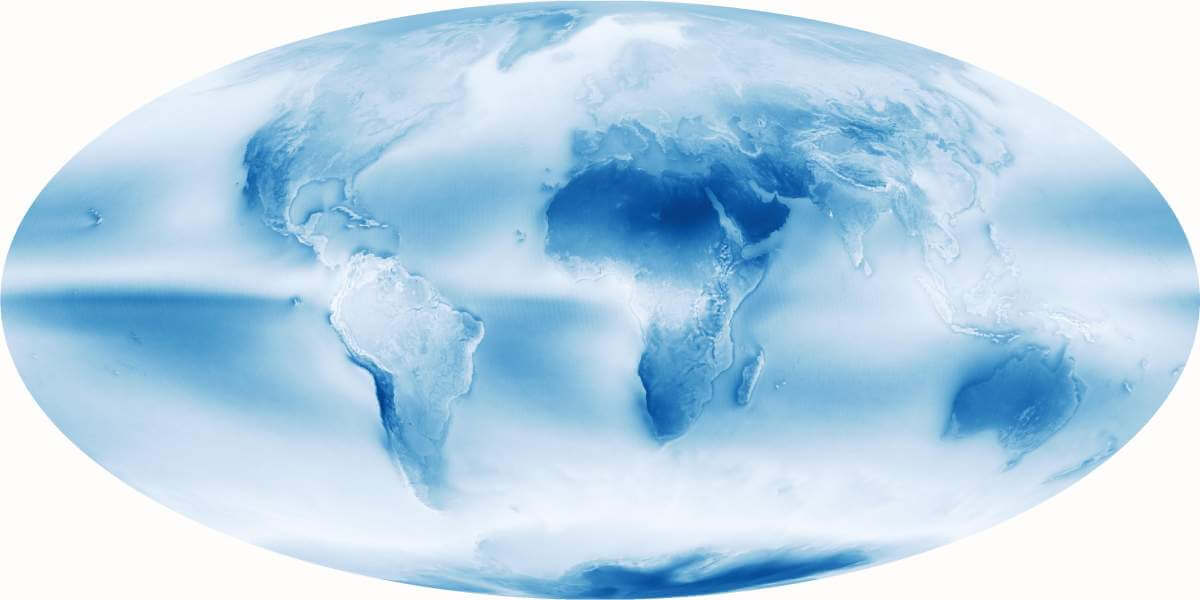Weizmann Institute scientists offer a solution to a 50-year-old mystery
When looking at the Earth from space, its halves - the northern and the southern - appear equally bright. This fact is particularly surprising since the Southern Hemisphere is mostly covered in dark oceans, while large parts of the Northern Hemisphere are paved with light land areas. Over the years, the reason for this symmetry between the halves remained a mystery. In a new study, published this week in the scientific journal PNAS, the scientists of the Weizmann Institute of Science and their partners reveal the connection between the intensity of storms and cloudiness rates and the degree of reflection of solar energy in each of the hemispheres of the globe. In doing so, they offer a solution to the mystery, and even estimate how the return of radiation may change in the future due to climate change.
Already in the 70s of the last century when scientists analyzed the first meteorological satellite data, they recognized that, surprisingly, both halves of the Earth reflect the same amount of solar radiation; Reflectivity known in the professional language as "albedo". To better understand what albedo is, think about driving at night: how easy it is to spot the white dividing line, which reflects the light from the car's headlights well, but how hard it is to see the dark asphalt. The same is true when observing the Earth from space - the ratio between the solar energy that strikes and that which is reflected from each and every region of the Earth depends on various factors, including the ratio between dark oceans and light land, which, just like the asphalt and the dividing line, differ in their degree of reflectivity. In the Northern Hemisphere the land area is about twice as large as in the Southern Hemisphere, and indeed when measured near the surface in clear skies there are differences of more than 10% in albedo. And yet, in the atmosphere, the halves appear equally bright.
In the new study, led by Prof. Yohai Caspi and research student Or Hadas from the Department of Earth and Planetary Sciences at the institute, the scientists focused on the factor that is at high altitude and reflects radiation from the sun - the clouds. The scientists analyzed data from the most advanced databases in the world, including cloud data collected by NASA satellites (CERES) and data from ERA5, a global weather database containing information collected from a variety of sources in the air and on the ground since 1950. The information in the ERA5 database allowed the completion of The cloudiness data and a 50-year cross-reference of this data with corresponding information on the intensity of storms.
""The reflectivity of the solar radiation from the clouds originating from the strong storms in the southern half, balances with a high level of precision the reflectivity originating from the large land area in the northern half"
The scientists classified the storms that occurred in these years into three groups according to their intensity, and revealed a direct relationship between the intensity of the storms and the amount of clouds that form around them. They noticed that land areas, and the northern hemisphere in general, are characterized by weaker storms - while moderate and strong storms are more common in the southern hemisphere and over the oceans. From the analysis of the data it emerged that the relationship between the amount of clouds and the intensity of the storms, well explains differences in clouds between the two hemispheres. "The albedo of the clouds, as a result of the strong storms in the southern hemisphere, was found to balance with a high level of precision the albedo that originates from the large land area in the northern hemisphere," says Hadas and adds: "This proves that storms are the factor that links the brightness of the surface and the clouds, and thus the symmetry of the albedo between the two hemispheres is maintained -Country".

Will climate change make one hemisphere darker?
In recent years the Earth is changing rapidly. To examine whether and how climate change will affect albedo symmetry, the researchers used CMIP6, a set of models run by climate research centers around the world in an attempt to predict climate change. One of the main disadvantages of these models is their limited ability to provide predictions on the degree of cloud cover. However, the relationship found in the study between the intensity of the storms and the cloudiness allows to deduce the degree of cloudiness from the forecast of the storms.
According to these models, climate change will result in a decrease in the frequency of all storms in the Northern Hemisphere and of weak and moderate storms in the Southern Hemisphere. However, the strongest storms in the southern hemisphere will intensify. The reason for these predicted differences is the "Arctic Amplification" in the Northern Hemisphere, a phenomenon in which the North Pole warms at least twice as fast as the global average. Apparently, it could be expected that this difference would break the symmetry in albedo, but the research findings show that in very strong storms the amount of clouds reaches saturation. Therefore, a further increase in their intensity will not change the degree of cloudiness, and it is possible that the symmetry will be preserved.

"It is not yet possible to determine with certainty whether the albedo symmetry will be broken due to global warming," says Prof. Caspi, "however, the new research answers a fundamental question and expands our understanding of the radiation balance of the Earth and the factors that influence it. When we come to deal with climate change, it will be necessary to develop geo-engineering solutions that will allow us to live alongside it. I am hopeful that understanding basic climatic phenomena, such as the symmetry in albedo, will help in the development of these solutions."
Dr. George Dasris and Prof. Bjorn Stevens from the Max Planck Institute for Meteorology in Hamburg also participated in the study; Dr. Joaquin Blanco and Prof. Rodrigo Caballero from Stockholm University; and Dr. Sandrine Boni from Sorbonne University in Paris.
More of the topic in Hayadan:
- Towards the next storm - less rainy winters, but the storms will be more powerful and concentrated
- Extensive afforestation of arid areas will not moderate global warming and may even make it worse
- The snow is artificial, but the crisis is real: about the lack of snow at the ski resort
- The weather in the Middle East during the last ice age contributed to the movement of people to permanent settlements
